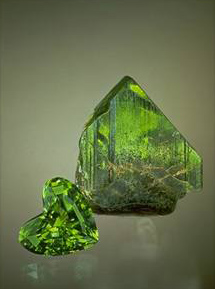Isomorphism (crystallography) on:
[Wikipedia]
[Google]
[Amazon]
 In chemistry isomorphism has meanings both at the level of crystallography and at a molecular level. In
In chemistry isomorphism has meanings both at the level of crystallography and at a molecular level. In
 In chemistry isomorphism has meanings both at the level of crystallography and at a molecular level. In
In chemistry isomorphism has meanings both at the level of crystallography and at a molecular level. In crystallography
Crystallography is the experimental science of determining the arrangement of atoms in crystalline solids. Crystallography is a fundamental subject in the fields of materials science and solid-state physics (condensed matter physics). The wo ...
, compounds are isomorphous if their symmetry is the same and their unit cell parameters are similar
Molecules are isomorphous if they have similar shapes. The coordination complex
A coordination complex consists of a central atom or ion, which is usually metallic and is called the ''coordination centre'', and a surrounding array of bound molecules or ions, that are in turn known as ''ligands'' or complexing agents. Many ...
es tris(acetylacetonato)iron (Fe(acac)3) and tris(acetylacetonato)aluminium (Al(acac)3) are isomorphous. These compounds, both of ''D''3 symmetry have very similar shapes, as determined by bond lengths and bond angles. Isomorphous compounds give rise to isomorphous crystals and form solid solutions. Historically, crystal shape was defined by measuring the angles between crystal faces with a goniometer. Whereas crystals of Fe(acac)3 are deep red and crystals of Al(acac)3 are colorless, a solid solution of the two, i.e. Fe1−xAlx(acac)3 will be deep or pale pink depending on the Fe/Al ratio, x.
Double sulfate
An alum () is a type of chemical compound, usually a hydrated double sulfate salt of aluminium with the general formula , where is a monovalent cation such as potassium or ammonium. By itself, "alum" often refers to potassium alum, with the ...
s, such as Tutton's salt, with the generic formula MI2MII(SO4)2.6H2O, where MI is an alkali metal and MII is a divalent ion of Mg, Mn, Fe, Co, Ni, Cu or Zn, form a series of isomorphous compounds which were important in the nineteenth century in establishing the correct atomic weight
Relative atomic mass (symbol: ''A''; sometimes abbreviated RAM or r.a.m.), also known by the deprecated synonym atomic weight, is a dimensionless physical quantity defined as the ratio of the average mass of atoms of a chemical element in a give ...
s of the transition elements. Alum
An alum () is a type of chemical compound, usually a hydrated double sulfate salt of aluminium with the general formula , where is a monovalent cation such as potassium or ammonium. By itself, "alum" often refers to potassium alum, with t ...
s, such as KAl(SO4)2.12H2O, are another series of isomorphous compounds, though there are three series of alums with similar external structures, but slightly different internal structures. Many spinel
Spinel () is the magnesium/aluminium member of the larger spinel group of minerals. It has the formula in the cubic crystal system. Its name comes from the Latin word , which means ''spine'' in reference to its pointed crystals.
Properties
...
s are also isomorphous.
In order to form isomorphous crystals two substances must have the same chemical formulation (i.e., atoms in the same ratio), they must contain atoms which have corresponding chemical properties and the sizes of corresponding atoms should be similar. These requirements ensure that the forces within and between molecules and ions are approximately similar and result in crystals that have the same internal structure. Even though the space group is the same, the unit cell dimensions will be slightly different because of the different sizes of the atoms involved.
Mitscherlich's law
Mitscherlich's law of isomorphism, or the law of isomorphism, is anapproximate
An approximation is anything that is intentionally similar but not exactly equal to something else.
Etymology and usage
The word ''approximation'' is derived from Latin ''approximatus'', from ''proximus'' meaning ''very near'' and the prefix ' ...
law suggesting that crystals composed of the same number of similar elements tend to demonstrate isomorphism.
Mitscherlich's law is named for German chemist Eilhard Mitscherlich, who formulated the law and published it between 1819 and 1823.
According to Ferenc Szabadváry
Ferenc Szabadváry (1 September 1923 – 21 May 2006) was a Hungarian chemist and historian. From 1971 he was director at the Hungarian National Museum for Science and Technology.
In 1960 he published a history of analytical chemistry in Hu ...
, one of the clues that helped Berzelius determine the atomic weights of the elements was "the discovery of Mitscherlich that compounds which contain the same number of atoms and have similar structures, exhibit similar crystal forms (isomorphism)."
See also
* Asterism (gemology) *Polymorphism (materials science)
In materials science, polymorphism describes the existence of a solid material in more than one form or crystal structure. Polymorphism is a form of isomerism. Any crystalline material can exhibit the phenomenon. Allotropy refers to polymorphism ...
* Goldschmidt tolerance factor
* Solid solution
* Vegard's law
References
{{reflist Crystallography Mineralogy concepts